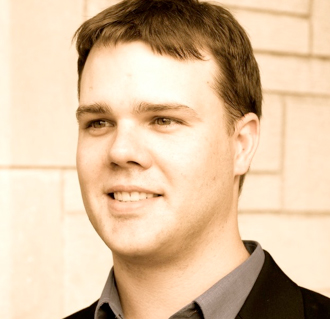by Jarrett Hoffman

On Saturday, March 21 at 7:30 pm at Baldwin Wallace University’s Gamble Auditorium, NEOSonicFest 2015, a five-concert festival of new music, will continue with a concert by the Cleveland Chamber Symphony under the direction of Steven Smith, with special guests Verb Ballets. Headlining the evening is the world premiere of Clint Needham’s Imaginary Dances (made real), choreographed by Sara Whale. The program will also include two other world premieres by Jeremy Allen and Smith, as well as Henry Cowell’s Hymn and Fuguing Tune No. 10. A donation of $10 (or $5 for students) is suggested.
Needham, a graduate of Baldwin Wallace Conservatory of Music and Indiana University Jacobs School of Music, is currently Composer-In-Residence and Assistant Professor of Music at BW. Speaking with him by telephone, I asked him what it’s like to teach at his alma mater.
“It’s great. BW is an excellent school, and the faculty was really welcoming to me when I came back. It wasn’t awkward with people who had been my teachers and were now my colleagues. I think that’s pretty lucky. I’ve heard about a lot of situations where that hasn’t been the case.”
Speaking of BW, I asked Needham about the school’s Fyoo zh en (pronounced fusion) concerts of new music with dance, a program co-directed by Sara Whale. “Sara’s student choreographers and my student composers team up to put together these concerts,” he explained. “There are growing pains. A lot of students have never collaborated on a work of art in a synergistic way. Choreographers often take pre-existing music that has already been recorded and create a dance to it, and composers write what they want. But when there are two people consulting on the same work of art, it’s an interesting process.”
On transitioning from that level of collaboration with Whale to actually working on a project with her, Needham said, “It sort of came about organically. Our students were collaborating, and we appreciated each other’s work. I was also impressed with how she coaches her students. When I was awarded the Cleveland Creative Workforce Fellowship from Cuyahoga Arts and Culture, I knew I wanted to work with her.”
Needham talked me through his thought process during the composition of Imaginary Dances (made real). “I was trying to get into the mind of a choreographer. I was thinking about how there is a lot of orchestral music that is dance-oriented but isn’t a ballet. Then there are the pieces chosen by choreographers — pieces that also weren’t meant to be danced to, but are anyway. I wondered what it is about those kinds of music that makes them feel the way they do, or that draws choreographers to them.
“I decided that I was going to write a set of pieces called Imaginary Dances. The music itself is pure — it can certainly be performed as concert works. But they were crafted with the notion of movement in mind. I didn’t get to work with Sara on the crafting of the pieces as much as I wanted, because we were both very busy. But we talked initially and had a similar idea, and I went with that. But between the two of us, we’ve created something a lot bigger than we each imagined, which I think is a really cool thing. And I couldn’t be happier with the Cleveland Chamber Symphony and the support I’ve gotten in Cleveland.”
Imaginary Dances (made real) clocks in at about 25 minutes — fairly long for a contemporary orchestra piece. “It’s really wonderful to be commissioned to write these longer orchestra pieces,” said Needham. “I have one in the works for the Albany Symphony, and I’m doing another one for Akron next year. But they’re also hard to get played again after the novelty of the premiere wears off. It becomes difficult to shop them around.”
Needham mentioned the trend of orchestras opening concerts with a shorter new piece (five to ten minutes in length). “Get it out of the way, then move on to Beethoven,” he said, laughing. “There are some orchestras, like LA, St. Louis, Detroit, and Atlanta, that take a chance and program longer contemporary pieces. It’s not common, unfortunately.”
Still, Needham sees some change. “There are musicians out there for whom the orchestral model and recreating Beethoven over and over and over isn’t exciting. So they create their own groups, like the Cleveland Chamber Symphony, Alarm Will Sound, and eighth blackbird. I was looking at the past decade or so of Grammy winners in chamber music, and seriously, about half of them have been for new music. I think eighth blackbird has won twice. And Hilary Hahn won this year with her In 27 Pieces, a set of encores that she commissioned. So I think there is more of a desire out there for new music than a lot of orchestras give audiences credit for.
“I hope the 21st century is more open. Maybe the era of longing for and trying to recreate the past will end. I don’t know. We’ll see.”
Published on ClevelandClassical.com March 17, 2015.
Click here for a printable copy of this article


